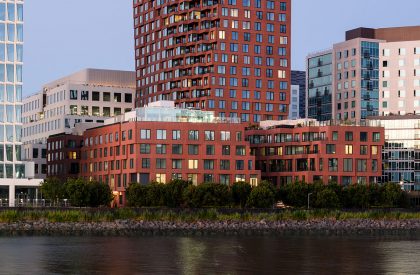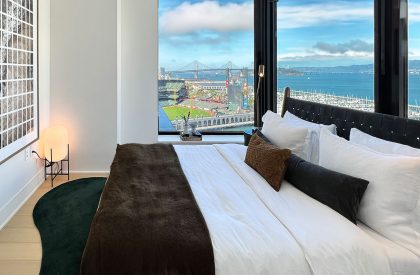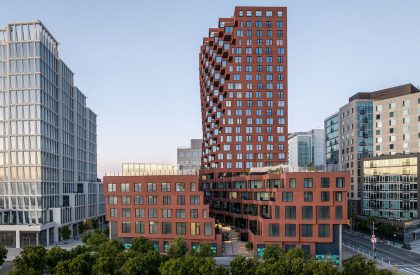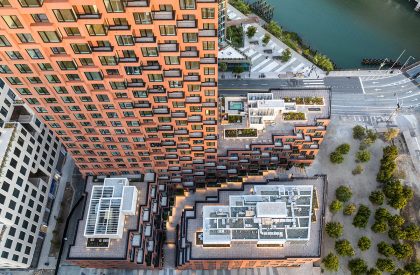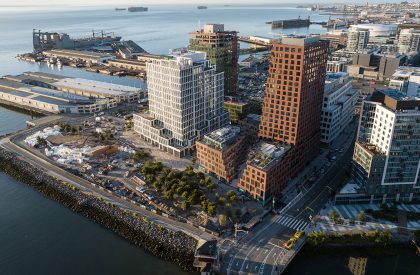Excerpt: MVRDV’s The Canyon, a 23-story mixed-use building in San Francisco’s Mission Rock, is part of a sustainable neighborhood and aims to house middle-income residents. The Canyon features a public “canyon” and a rugged red-brown façade, connecting to offices and shared amenities. The building’s design creates a sense of topography and connects to the neighborhood, making it accessible to nurses, teachers, and essential workers. The project is part of a partnership between the Giants, Tishman Speyer, and the Port of San Francisco.
Project Description
[Text as submitted by architect] The geology-inspired sustainable tower “The Canyon” is completed in San Francisco’s Mission Rock, with the first residents moving in.
The Canyon, a 23-story mixed-use building designed by MVRDV, was officially opened on June 21 in a ceremony attended by San Francisco Mayor London Breed, and the first residents are now moving in. The project was built as part of a master plan that transforms a windswept parking lot on San Francisco’s waterfront into a new sustainable neighborhood, known as Mission Rock, with housing for middle-income residents. With its jagged walls and a publicly accessible “canyon” providing a route through the site, The Canyon is reminiscent of the dramatic geology of California, inspired in part by San Francisco’s charismatic topography. As MVRDV’s first completed project on the West Coast, The Canyon aims to introduce a mixture of local sensitivity and a cosmopolitan approach in everything from the building’s public space to its mix of functions to the apartments it provides.

Located opposite the Giants’ Oracle Park stadium, The Canyon is one of four buildings that form the first phase of the new Mission Rock neighborhood, which is being developed through a partnership between the San Francisco Giants, Tishman Speyer, and the Port of San Francisco. These buildings were designed in a collaborative process in which four internationally renowned design firms—Studio Gang, Henning Larsen, and WorkAC, in addition to MVRDV—worked simultaneously, creating designs that worked seamlessly together while each having a distinct appearance.
With its position in the northwest corner of the neighborhood, The Canyon is the first thing visitors see when crossing the 3rd Street Bridge and will soon be fronted by China Basin Park, a waterfront park and cultural centerpiece for the community. The building comprises a five-story plinth topped by a 73-meter (240-foot) tower in the western corner of the plot. Like all the buildings in the master plan, the ground level of The Canyon hosts small-scale shops and restaurants that will help establish a community feel in the new neighborhood.
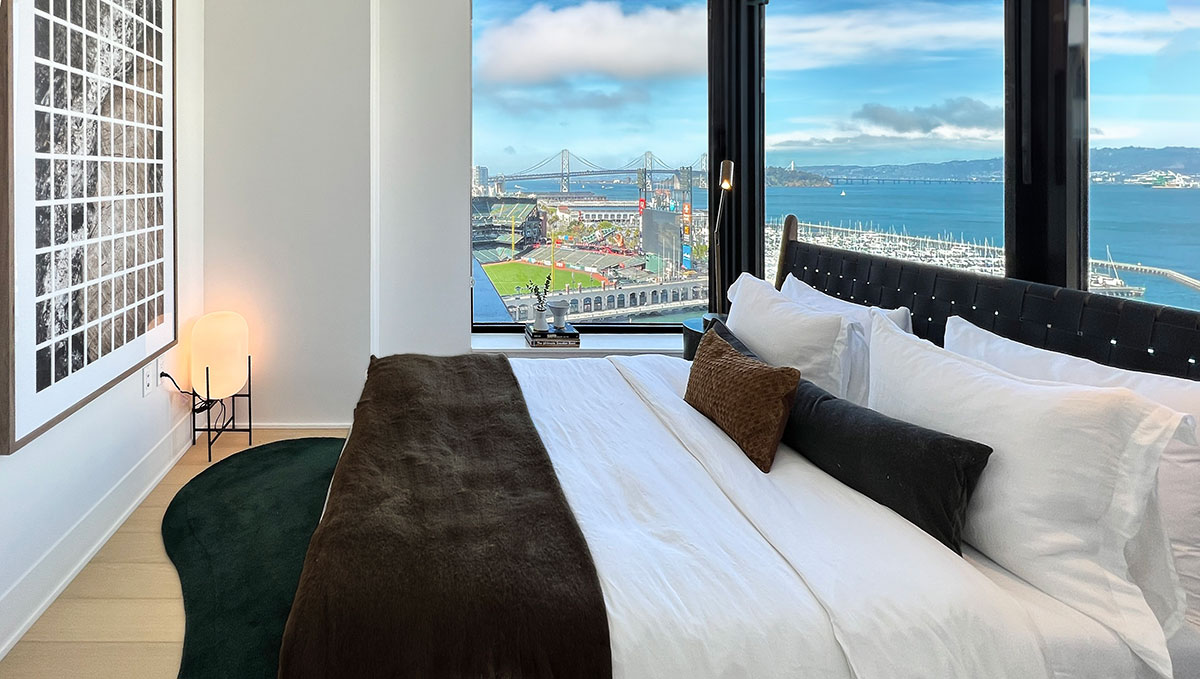
In the case of The Canyon, the ground floor is topped by two floors of offices and then 283 apartments. Over a third of these apartments are rented below market rate, with residents selected via a lottery process, providing 102 homes for middle-income families and thus helping to alleviate San Francisco’s housing crisis.
The Canyon is instantly recognizable thanks to its ruggedly textured red-brown façade. The design references Californian rock formations and features a landscaped public “canyon” that cuts diagonally through the building’s plinth, connecting to the offices and to shared amenities for residents. Providing a lush and lively space for both relaxing and working, the canyon also offers a shortcut from China Basin Park to the heart of the neighborhood.
The walls of the canyon and of the eastern side of the tower are jagged with step-backs and overhangs, giving the impression of steep rocky walls. These have the added benefit of creating bay windows and small balconies for 40 apartments, taking advantage of the views over San Francisco Bay. The roofs of the plinth are also landscaped with abundant greenery, creating communal spaces for residents to relax, exercise, or meet friends.
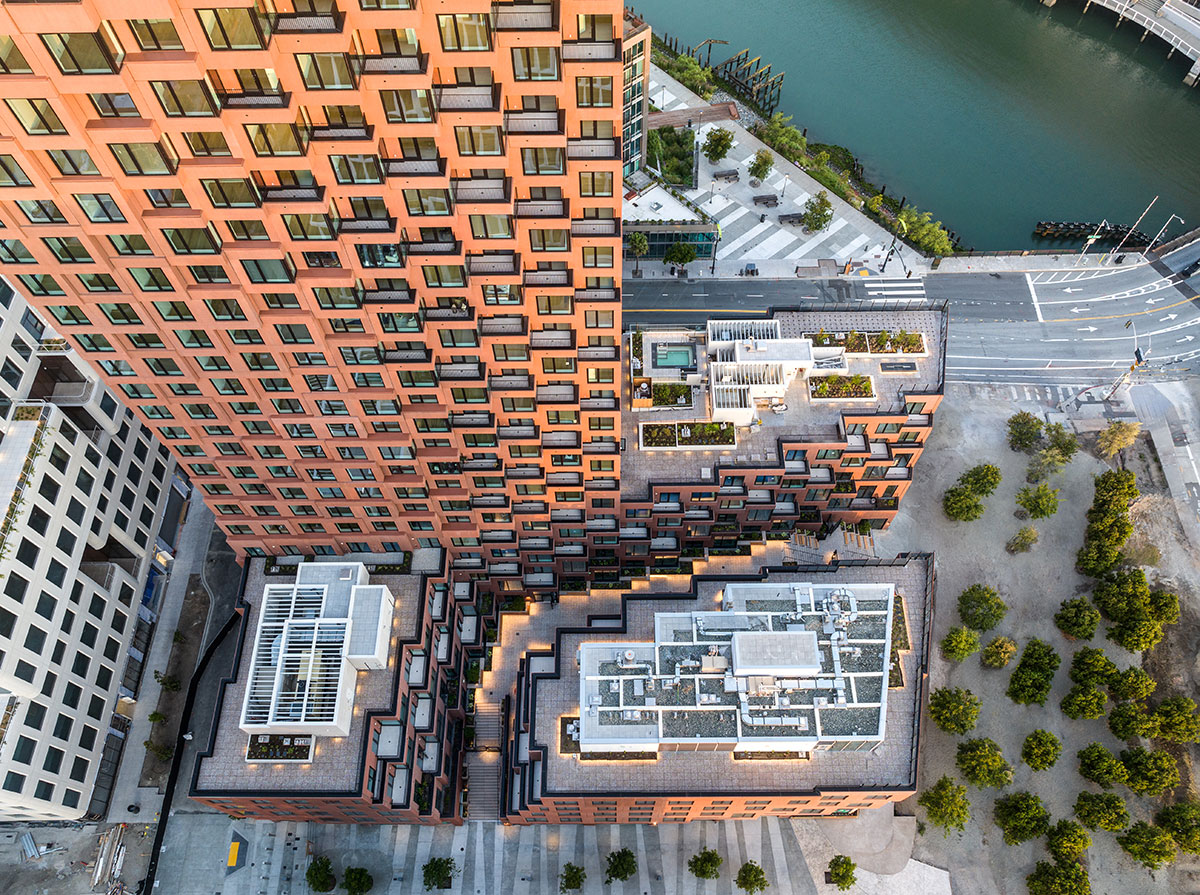
“With our design, we introduce a feeling of topography to make the building very much connected to its location”, says MVRDV founding partner Nathalie de Vries. “Crucially, this approach also enabled us to contribute to a lively neighborhood: with the public ravine as its focal point, The Canyon creates a landscape of activity where the public realm connects to the shops, offices, and homes to keep Mission Rock busy and alive. And, thanks to the inclusion of below-market-rate rentals, it’s a neighborhood that will be accessible to the city’s nurses, teachers, and other essential workers that keep the city running.”
One benefit of the simultaneous design process for the master plan is that the four buildings share critical energy and water infrastructure. Based in the building designed by Work AC, for example, is a water recycling plant that will process black water from the whole neighborhood for reuse. For its part, The Canyon hosts the key mechanical elements of an efficient district heating system, hidden away in parts of the ground floor and basement.
The site’s proximity to San Francisco Bay provides it with the opportunity to utilize bay water for both cooling and heating Mission Rock via a water exchange system. The system reduces CO2, lowers water and energy usage, and thus lowers utility bills for the tenants. Also located in the basement is bicycle parking, encouraging residents to take advantage of healthy and sustainable transport options. Together, these shared systems and interventions allow the neighborhood to significantly reduce its carbon emissions, and it will become one of the exemplary projects for the area.
The Canyon and the wider Mission Rock neighborhood are being developed in a partnership between the San Francisco Giants, Tishman Speyer, and the Port of San Francisco. MVRDV worked with executive architect Perry Architects, landscape architect GLS Landscape/Architecture, PAE Engineers, structural engineer Magnusson Klemencic Associates, and Swinerton Builders as contractors.

